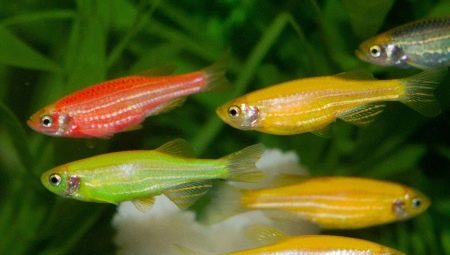Danio glofish aquarium fish attract many aquarists. They are easy to maintain and look great in the aquarium. From the bright fluorescent beauties it is impossible to take your eyes off. Such an aquarium will be an excellent decoration of the interior.

Description
Danio glofish - genetically modified fish. The genes of marine organisms were included in the structure of their DNA. Thanks to this, a lot of bright fluorescent colors were obtained: blue, purple, red, green, orange and lime. Fish of the red spectrum flowers got their color due to the DNA of the coral of the Discosome, and individuals of green hues owe their color to the jellyfish gene Ecuorea Victoria. Danio glofish look especially beautiful under fluorescent lamps.
The body structure of the glofish is the same as that of its closest relative - zebrafish: elongated, slightly flattened laterally. Expressive stripes run along the abdomen. The fins are transparent, in young individuals they are short, but as they grow older they lengthen, forming a thin veil. The fins can easily determine the approximate age of the fish. Glavish is slightly larger than regular zebrafish and can grow up to 5 cm. Life expectancy is 3-4 years. Rarely, but still there are long-livers - with good care, zebrafish glofish can live up to 5 years.
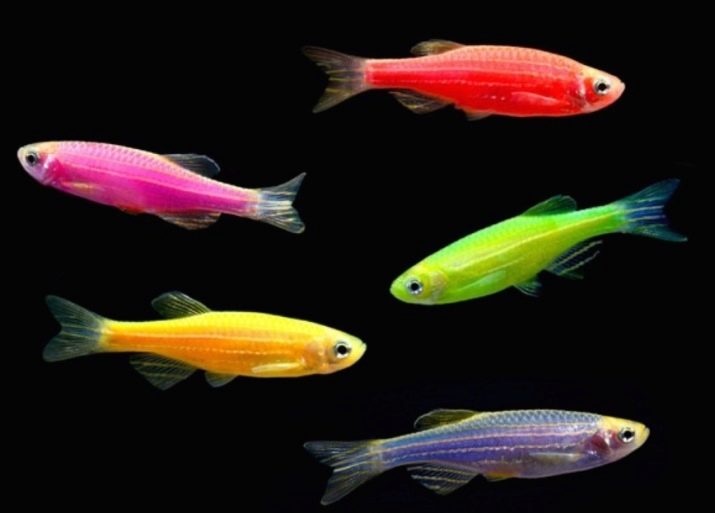
How to distinguish a female from a male
Danio's sexual dimorphism is poorly developed, but still there are some signs, by which you can determine the sex of an individual:
- females are larger than males by about 3-5 mm;
- the females are more pot-bellied, and the shape of the male’s body is more taut and elongated, similar to an arrow;
- the color of the male is more saturated, the stripes are more pronounced than that of the female;
- males are more active; they can chase females even outside the spawning period.
Differences between male and female are manifested by 5-6 months, at this time the individual reaches puberty. But most of all, sexual differences are noticeable during the spawning period: in females, the abdomen is rounded, and in males, the color becomes brighter.
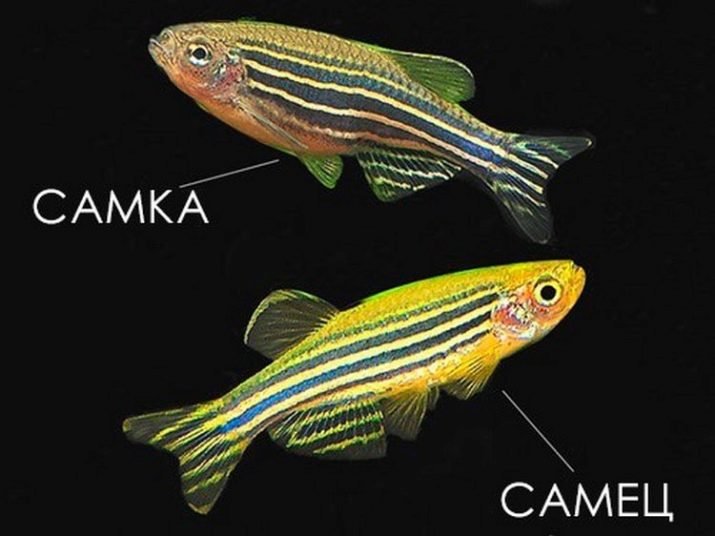
What types of fish can be kept with
Danio - schooling fish they will feel best in the company of the same fluorescent relatives, but get along with other peaceful species:
- neons;
- mollies;
- cardinals;
- Pecilia
- guppies;
- swordsmen;
- soms;
- laliuses.
Danios are very friendly, do not even touch small shrimps and snails, but they themselves can become food for larger predator fish.
Therefore, categorically they cannot be lodged with cichlids. The thorns and barbs are also inappropriate neighbors, as they bite the delicate fins of zebrafish. Content with goldfish is also unsuccessful and can be sad for both species. Nimble zebrafish can injure a clumsy neighbor, and a goldfish, in turn, can easily swallow miniature glofish.
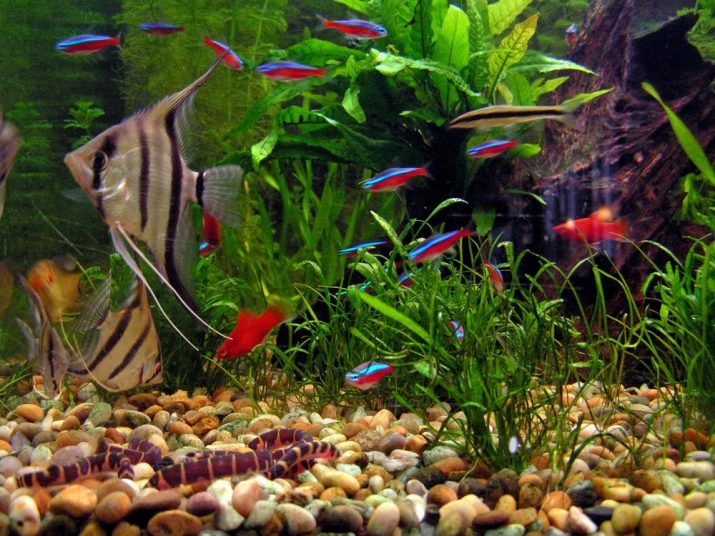
Maintenance and arrangement of the aquarium
Taking care of zebrafish glofish will not be difficult even for beginner aquarists. A flock of fish will be comfortable in a 60-liter rectangular aquarium. The larger the volume of the tank, the better, because in a large tank it is easier to maintain the purity and necessary parameters of water. In addition, active and frisky zebrafish love space. Glavish, unlike ordinary zebrafish, is sensitive to water parameters and more thermophilic. Water requirements are as follows:
- temperature - + 26–28 ° C;
- stiffness - 5-15 ° dH;
- acidity - 6.5–7.5 pH.
Soil for the aquarium in which fluorescent fish will live, it is better to choose a dark color. Against such a background, a bright color of a glossfish will advantageously look. The bottom is covered with coarse sand, crushed granite or small pebbles. You can place driftwood, grottoes and other decorations. Just do not clutter up the space too much, as zebrafish need space for games.
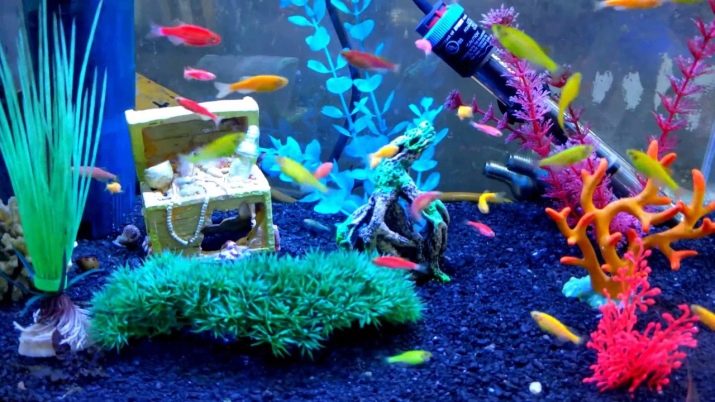
Some aquarists prefer to decorate a pond with artificial plants, they are bright and look very impressive in an aquarium with a glavish. But still it is recommended to plant at least a couple of bushes of live algae - this will create a favorable ecosystem for the fish. The following plants are especially suitable for a pond with a glavish:
- cryptocorin;
- hygrophil;
- sagittaria;
- echinodorus;
- Anubias
- elodea;
- Javanese moss.
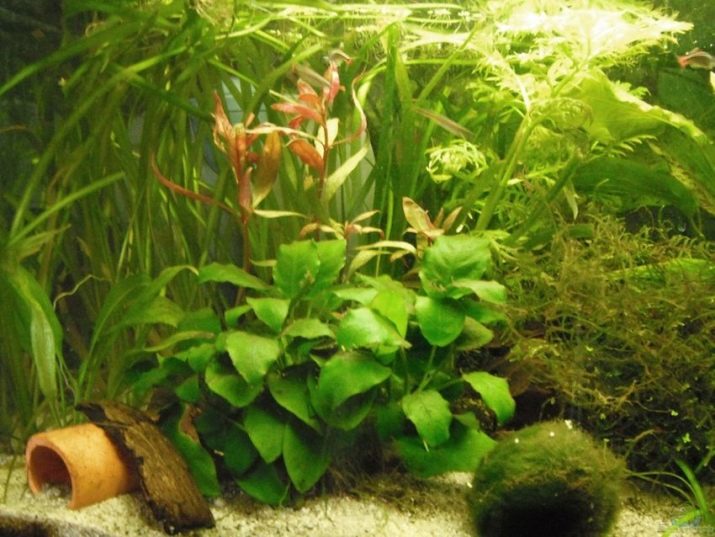
The aquarium is located away from direct sunlight and the heating system. In order to fully reveal the color of zebrafish glofish, special attention is paid to artificial lighting. It is best to use lights equipped with white and ultraviolet LEDs. Lamps for marine aquariums with multi-colored diodes are also suitable.
Aeration is desirable, especially in a densely populated aquarium. It is important to monitor the purity of water. Turbid water will not only cross out the aesthetic effect of the zebrafish glofish, but it can also kill fish. The aquarium is equipped with a filter and an additional water change is performed every week. To do this, using a bucket or hose, drain 20-25% of the water and fill in a new one. Fresh water must first settle in a dark place for 3-5 days. This will allow all harmful impurities to settle to the bottom.

Feeding
In the diet of genetically modified fish, high-quality dry food should prevail. It is preferable to choose flakes or chips, they stay longer on the surface of the water. Tetra produces fully balanced feeds for a variety of fish species. For danio glofish, it is recommended to buy Tetra Rubin Flakes. The composition of this feed contains natural color enhancers that enhance color. You can also give the fish Tetra Menu, TetraMin and Tetra Phyll Flakes.
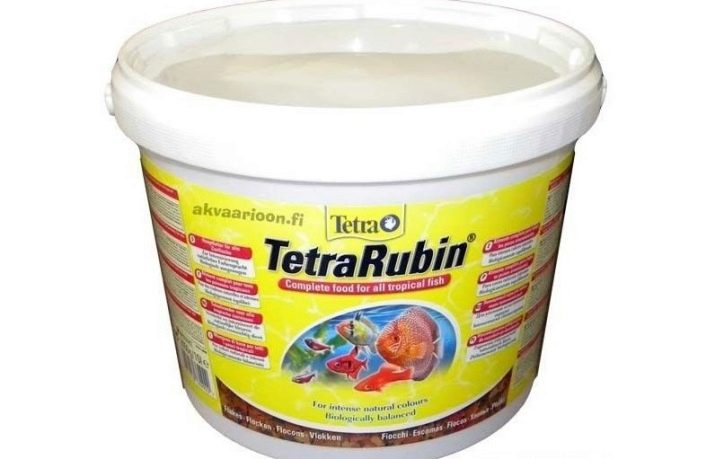
If you give only dry food, the fish may begin to hurt.Feeding should be varied, so do not forget to pamper the aquatic inhabitants and live food.
You can give bloodworms, tubule and coronet. The composition of live food contains a large amount of protein and nutrients that support the health of fish.
They are fed 2 times a day, preferably in the morning and in the evening 1-2 hours before turning off the light. Food is given in small portions, a serving should be eaten within 3-5 minutes. The remains of the feed must be removed, as during its decay harmful substances are released. Some aquarists recommend arranging fasting days once a month: fish are not fed for a day. This is an excellent prevention of obesity and other diseases of the digestive system.
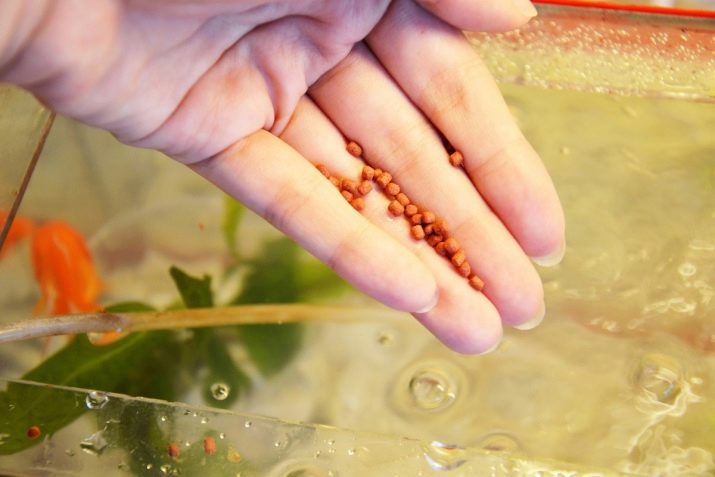
Breeding
Danio glofish can be bred at home, the color of the modified fish is fully transmitted to the offspring. For breeding choose one of the largest female and two bright males. It is desirable that all individuals be the same color. 1-2 weeks before spawning, the female and the males are planted in different aquariums and fed plenty of live food. At this time, you can start preparing spawning:
- a small aquarium is suitable - 10 l;
- a separator net is installed just above the bottom to protect the eggs from eating by adults;
- water temperature should be between + 28-30 degrees.
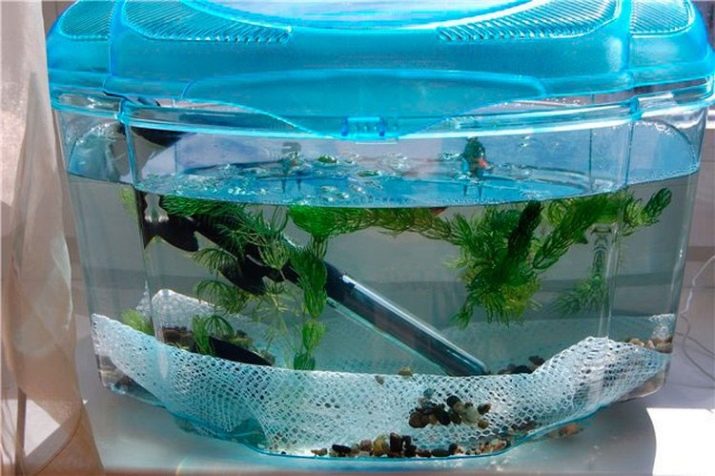
In a female ready for spawning, the abdomen is rounded off; as soon as this happens, the fish can be placed in the spawning ground. The female and the males are launched in the evening, and in the morning most often you can already watch love games. Males chase the female around the aquarium, and she spawns at this time. The whole process takes about 3 hours, after its completion, the fish are returned to the general aquarium.
After 4 days, larvae emerge from the eggs, which feed on the yolk sac and so far do not need additional feeding. After 3-4 days, fry form, they begin to swim through the pond in search of food. Toddlers are fed live dust and artemia nauplii. You can also give Tetra special food for fry. Danio glofish grow rapidly, and after 1-1.5 months they will be completely similar to their parents. At this time, they can be transplanted into a common aquarium.
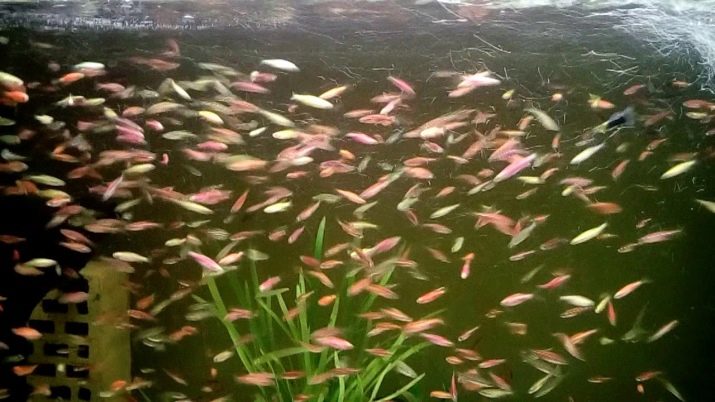
Possible problems
Danio glofish have good health, but sometimes these beautiful fish can get sick. Among the most common ailments, the following 3 diseases can be noted.
- Eyebrows. The name speaks for itself, the eyes of the fish begin to literally fall out of the orbits. The causes of the disease can be different: from non-compliance with water parameters to the presence of fungus in the aquarium. Treatment is selected individually, using magnesium sulfate or antibiotics.
- Trichodinosis. The infection, due to which a cloudy coating forms on the body, the fish begins to rub its abdomen against stones and decor items. The disease is successfully treated with baths with the addition of salt.
- Tuberculosis. A dangerous ailment, a sick individual becomes lethargic, pale, fins are destroyed, the stomach swells and the spine bends. The treatment is complex, apply “Ftivazid” and “Kanamycin”. It is not always possible to completely cure fish, only to stop the course of the disease.
Most often, all problems arise from poor care and poor quality food.
Danio glofish are sensitive to water indicators, therefore it is recommended to use special tests to determine its parameters. Healthy zebrafish glofish are active, playful and, when moving, beautifully shimmer in the aquarium with different colors.

About the species, contents and breeding of zebrafish fish, see the next video.
